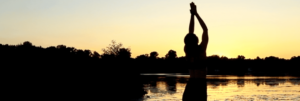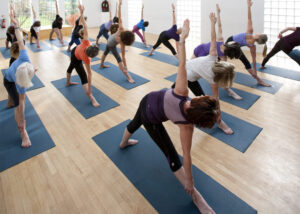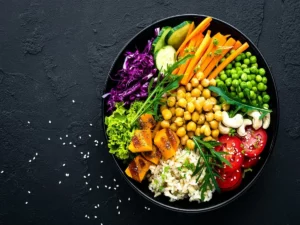If you are breathing, you are living. This fact is not up for debate and it is the foundation upon which pranayama is built.
Scientifically speaking, breathing can technically be described as an involuntary bodily process. As humans, we breathe every day, hour, and minute – no matter if we are awake or we are sleeping. However, even though breathing is inherently an involuntary action, we do also have the ability to subvert this and engage in voluntary breathing. We control this voluntary breathing through our brain’s motor cortex. This is the same area that is responsible for controlling body parts such as our legs and fingers.
So, why would you want to take direct control of your breathing if your body is perfectly capable of taking care of it involuntarily? What exactly is pranayama breathing? How can these breathing techniques serve as a positive influence in your life?
Keep on reading to find the answers to these questions and more!
What Is Pranayama? Getting A Better Understanding
A lot of contemporary lessons will oftentimes teach that pranayama is merely a form of breath control. Although this is not wrong, it is also not correct as well. Calling pranayama a form of breath control is a very simplistic way of viewing things because it is far much more than that.
Pranayama is a means by which a person can exert control over their life force – subsequently increasing it, regulating it, and controlling it. To get a better understanding of pranayama we first have to take a closer look at the concept of “prana”.
What Is “Prana”?
Like many of the other principles that yoga focuses on, prana is by no means a new concept. As a matter of fact, countless yogis and Indian spiritualists have embraced the concept of prana for hundreds of years.
When viewed through the lens of yoga, prana is a Sanskrit word that can be defined as the “universal life force” or “universal energy”. This life force flows through a complex network of energy centers (referred to as “chakra”) and energy channels (referred to as “nadi”). It is taught that prana is the life force that differentiates the living from the dead, it is the vital energy that we all require. Prana is what keeps us alive – whether we are aware of it or not – without it, our bodies would wither and die.
It is also worth noting that as a concept, prana has been interpreted in several different ways; all of which are correct in their own ways. For example, many yogis advocate for teachings that state that our universe is a manifestation of prana. However, on a more personal level, prana can be interpreted as the energy of consciousness. Furthermore, on an even more straightforward level, prana is simply the physical breath that we all must take to survive.
What Are Some Sources Of Prana?
If prana can be defined as the “universal life force” or “universal energy”, then it should stand to reason that it is all around us. However, for humans, there are a limited amount of ways that we can increase and sustain our prana level. There are four major ways that we can influence our prana level. The first three are fairly straightforward, they are rest, food, and breath. The fourth one is somewhat abstract as it is characterized as “being in a calm frame of mind” (or happy frame of mind).
Even these specific ways that we can affect our prana level are not all equal. For example, when it comes to rest, your overall level of comfort and your sleep quality will directly affect your prana level. Likewise, all foods are not equal and prana benefits are not dependent on taste. Instead, foods that are stale, canned, or frozen are unequivocally viewed as having less prana while fresh foods have more prana. In this same vein, meat is often seen as having low (or sometimes negative) prana due to it being dead. On the other hand, vegetarian foods are generally considered to have high prana.
However, although we aren’t constantly eating or resting, we are constantly breathing to survive. As a result of this, breathing is viewed as being our body’s most immediate source of prana. How we breathe significantly affects how we feel – which corresponds to our next question…
How Does Your Prana Level Affect You?
Your prana determines your state of mind. More specifically, the way that your prana flows – in addition to its quality and quantity – affects your overall state of mind. So, although prana is a part of everyone’s life, if they aren’t actively paying attention to it, the flow may be blocked or broken. This can ultimately result in increased feelings of tension, fear, doubt, depression, and so much more.
However, if you have a high prana level that is steady and smooth, then you will ultimately have a mindset that is positive, calm, and happy.
As An Addendum – What Is “Ayama”?
Ayama is a Sanskrit word that broadly translates to stretching, lengthening, extending, regulating, or control. So, if we look through the lens of yoga, it is easy to see why ayama is considered to be symbolic of the “extension of breath”.
Therefore, if we combine the definitions of both halves of the term “pranayama”, we could then say that it is the “control of life force”. This leads us to our next point…
What Are The Benefits Of Pranayama?
It doesn’t matter if you’re asking in the context of traditional medicine or contemporary medicine, breathing exercises have a wide range of proven benefits.
In the context of traditional eastern medicine, everything is linked to the flow of prana in the body. If this flow is blocked or suppressed, a person can eventually be subjected to diseases and illnesses. Likewise, if you can control this flow of energy, you can balance your body and even heal it.
On the more contemporary side of things, pranayama breathing has been linked to more stable emotional states and moods, as well as lower blood pressure.
Here is a definitive list of some of the most evident pranayama breathing benefits:
- Enhanced mental concentration.
- Improved lung function.
- Enhanced cardiovascular health.
- Reduced risk of high blood pressure.
- Improves focus and attention span.
- Increases energy levels.
- Boosted immune system.
- Somatic detoxification.
How To Practice Pranayama For Different Needs
There are several different types of pranayama breathing but all of them have three overarching (and very distinct) stages. These three phases of pranayama breathing are:
- Purak (inhalation)
- Kumbhak (retention)
- Rechak (exhalation)
All types of pranayama breathing will inevitably cycle through these three phases. However, the rate of breathing and the techniques that are used will vary depending on the type of pranayama.
Ujjayi Pranayama – Victorious Breath
Even if you are relatively new to yoga, there is still a high chance that you’ve come across (or even performed) ujjayi pranayama breathing without even realizing it. This is because ujjayi pranayama breathing is used in a lot of contemporary yoga classes. In addition to this, it is also often used as the foundational breath in ashtanga and vinyasa classes.
The term “ujjayi” means “victorious breath” and its technique is supposed to mimic the sound of the ocean’s waves. As a result of this, it is also often referred to as “ocean breath” as well.
First, breathe through your mouth and then constrict the back of your throat. If done correctly it should be as if you are about to try and fog up a mirror with your breath.
Now, close your mouth, keep your throat constricted, and then continue to breathe through your nose. This type of breathing is perfect for focusing your wandering mind during meditation.
Nadi Shodhana – Alternate Nostril Breathing
As the name would suggest, this technique is focused on breathing through one nostril at a time.
First, you should get into a comfortable seated position. Then, use your right thumb to close your right nostril. Now, take a deep breath through your left nostril; while visualizing that the breath is making its way up through the left side of your body. Pause and hold this breath for a moment.
Now, use the pinky and ring fingers on your right hand to hold your left nostril closed while you release your right nostril. Exhale through your right nostril; while visualizing that the breath is traveling down the right side of your body. Pause at the endpoint of your exhale.
Next, inhale through the right nostril while keeping the left one closed. Afterward, close your right nostril with your right thumb again and open your left nostril. Exhale through your left nostril, pausing at the endpoint of your exhale.
You have now completed one cycle of nadi shodhana. The primary purpose of this breathing technique is to balance the energy in your body.
Kapalabhati Pranayama – Breath Of Fire
This breathing technique’s title – “breath of fire” – is actually very fitting. This is because it is not only supposed to raise your vibrational pranic energy but it also builds up heat in your body. As a result of this, kapalabhati pranayama breathing is often used in kundalini yoga classes.
To start, open your mouth and pant like a dog. By doing so you should have a forceful exhale and an inhale that is almost automatic; focus on this exhalation.
Next, close your mouth but continue this same breathing through your nose. Try your best to visualize your diaphragm as it moves in and then pushes the breath out.
With a title like “breath of fire,” it is not surprising that this pranayama is relatively powerful but it is also potentially dangerous as well. It is not recommended that you use it (or at least take extra precautions) if you have high blood pressure, or you are pregnant or menstruating.
Essential Books For Pranayama
Having a complete mastery of yoga is an ever-fleeting goal; even the most experienced yogis in the world would agree with this fact. Continuous learning and practice are both key aspects of yoga. If you want to learn more about pranayama yoga – or even other types of yogic breathing techniques – here are some books that can help:
- Mind Your Breathing: The Yogi’s Handbook with 37 Pranayama Exercises by Sundar Balasubramanian
- The Power of Breath: The Art of Breathing Well for Harmony, Happiness and Health by Swami Saradananda
- The Science of Pranayama by Swami Sivananda
- The Yoga of Breath: A Step-by-Step Guide to Pranayama by Richard Rosen
- Light on Pranayama: The Yogic Art of Breathing by B. K. S. Iyengar
- Pranayama beyond the Fundamentals: An In-Depth Guide to Yogic Breathing by Richard
- The Breathing Book: Good Health and Vitality Through Essential Breath Work by Donna Farhi
- The Yoga of Breath: A Step-by-Step Guide to Pranayama by Rodney Yee
- Pranayama Rahasya (secrets of pranayama) by Swami Ramdev
- The Hindu-Yogi Science of Breath by Yogi Ramacharaka







